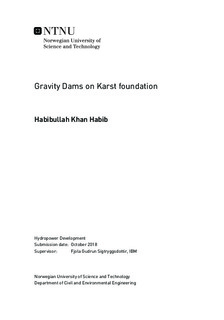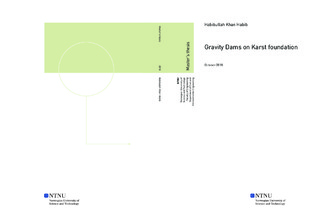| dc.description.abstract | Foundations with dissolvable limestone possess difficult situation for the dams. Several dams around the world are either abandoned and never used such as Anchor Dam (USA) or requires continuous maintenance e.g Mosal dam (Iraq) due to the presence of karsts/cavities/caverns in their foundation. This thesis considers one such difficult dam site, the proposed Almar dam site in the north of Afghanistan and investigates how the foundation conditions may affect the stability of the 67 m high gravity dam proposed for this location.
The Almar dam site has visual signs of karst cavities at its abutments, and the foundation consists of weak limestone/dolomite, gypsum and chalk and are considered as stiff soil during the stability analyses conducted as a part of this work. Gypsum (CaSO4:2H2O) which is precipitated limestone have low strength and are prone to large settlement when soaked. Fifteen boreholes of various depths were drilled at the dam site, and borehole no A10 near the toe of the dam show existence of possible karst cavity. Due to the remoteness of the dam site, and security risks incomplete and insufficient subsurface investigations were carried out, and many parameters values in this analysis were taken from reference studies.
The dissolution rate of limestone of 141 mg/litre was found using Roque s curves, which can result in reduced contact surface between the dam and its foundation. To initiate failure, the contact width of dam body with its foundation must reduce from its designed based-width of 53.3 m to 37 m.
Induced stresses at different depths within the foundation were estimated to check if they would cause collapse of hidden karst cavities. For example, At a depth of 16 meters below the base of the dam, the induced stresses from this 67 m high gravity dam would be 705 KPa (750 kPa as measured by Plaxis-2D).
The foundation was further evaluated for (a) Bearing capacity failure, (b) Settlement. Bearing capacity was found to be 6,581 KPa as per Terzaghi method, and 6,106 KPa (Vesic method) assuming no cavities. FEM analysis also shows no bearing capacity failure for the empty dam except initial settlement of 2 cm. Classic method were then used to estimate total settlement of 573 mm by dividing the foundation strata into 5 layers. FEM shows foundation settlement of 600-700 mm and the crest of the dam moved downstream by 1.25 meters after the partial failure of the cavity at the toe.
Sensitivity analysis of design parameters e.g Cohesion, Friction angle etc, were carried. F.Ssliding significantly increased when cohesion of the foundation material is increased from 600 KPa to 1 MPa, but has no effects over F.S overturning. Similarly, tensile stress were developed at the toe of the dam when the dam is overtopped.
As a Conclusion, structural integrity of this 67 m high concrete gravity dam will be at risk as were found by this study if a settlement of 573 mm happens or if the cavities in the foundations fails suddenly, and thus requires active surveillance program. | |

